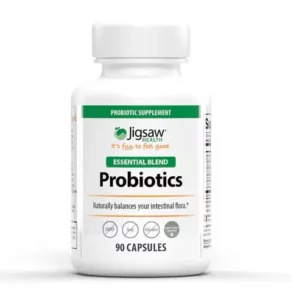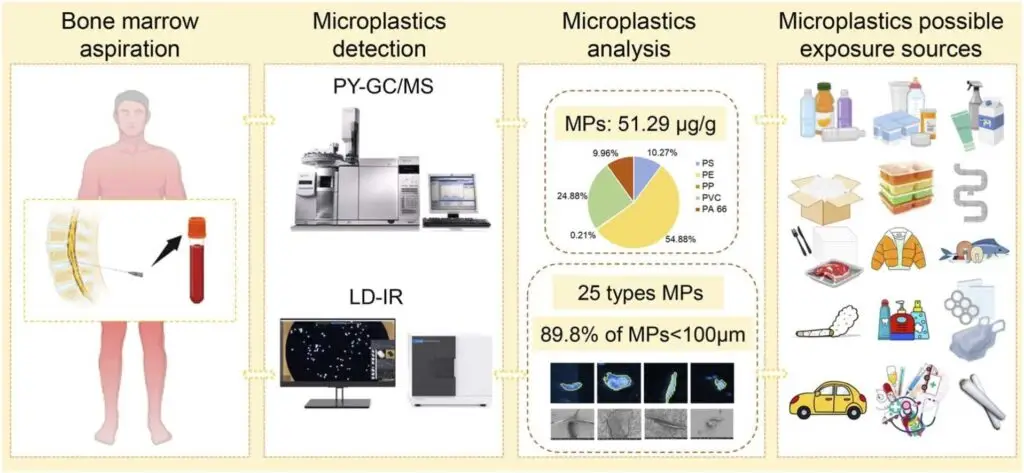This comprehensive exploration delves into the latest studies on microplastics’ effects on bone marrow and gut health, their interaction with gut microbiota, and the potential of probiotics to mitigate damage.
Microplastics in Bone Marrow: Invading the Body’s Blood Factory
A groundbreaking 2024 study revealed that MPs were present in all tested bone marrow samples. Utilizing advanced techniques such as pyrolysis gas chromatography-mass spectrometry (Py-GC/MS) and laser direct infrared spectroscopy (LD-IR), researchers identified the presence of polyethylene (PE), polystyrene (PS), polyvinyl chloride (PVC), and PA66 as predominant polymer types. The average concentration of MPs was 51.29 µg/g, with most particles ranging from 20 to 100 µm in size.
This study is the first to demonstrate that MPs can accumulate in bone marrow, a vital organ responsible for producing blood cells and maintaining immune defenses. These findings raise significant concerns about potential impacts on the hematopoietic system, including immune response dysregulation and metabolic disturbances.
Oxidative Stress and Chronic Inflammation
Microplastics are known to generate reactive oxygen species (ROS), creating an environment of oxidative stress in the bone marrow. This oxidative assault damages DNA and cellular structures, impairing the function of hematopoietic stem cells (HSCs). These stem cells are responsible for producing all blood cell types, and damage to them can lead to reduced immunity, anemia, and even an increased risk of cancers such as leukemia.
Chronic inflammation compounds the damage. Studies suggest that inflammatory cytokines, elevated in response to microplastic presence, disrupt the bone marrow niche—a microenvironment crucial for maintaining HSC function. Over time, this inflammatory milieu could exhaust the bone marrow’s regenerative capacity, leaving the body vulnerable to disease.
Systemic Effects of Bone Marrow Dysfunction
The consequences of microplastic-induced bone marrow damage extend beyond hematopoiesis. Disruptions in blood cell production can impair the immune response, hinder oxygen transport, and weaken the body’s ability to repair tissues. This systemic impact underscores the far-reaching effects of microplastics as they infiltrate critical bodily systems.
The Gut-Microplastic Connection: A Perfect Storm for Health
As one of the primary entry points for microplastics, the gastrointestinal (GI) tract bears the brunt of their harmful effects. Multiple studies reveal how microplastics accumulate in the gut, where they damage intestinal cells, disrupt microbiota balance, and trigger systemic inflammation.
Leaky Gut and Intestinal Permeability
Microplastics compromise the gut barrier by increasing intestinal permeability, a condition commonly known as “leaky gut.” Damaged tight junctions between intestinal cells allow harmful substances—including microplastics, toxins, and bacteria—to pass into the bloodstream. This sets off a cascade of systemic inflammation, taxing the liver, kidneys, and immune system.
Deng’s study demonstrated that microplastics contaminated with phthalate esters (PAEs) significantly aggravated these effects. PAEs are plastic additives that leach into the environment and accumulate on microplastic surfaces. When ingested, these compounds worsen gut inflammation, oxidative stress, and metabolic dysfunction. Mice exposed to microplastics with PAEs exhibited pronounced intestinal damage, increased inflammation, and altered gene expression.
Gut Dysbiosis: A Disruption of Microbial Harmony
The gut microbiota—a diverse community of trillions of microbes—plays a pivotal role in digestion, immune regulation, and overall health. Microplastics disrupt this delicate balance, leading to dysbiosis, a condition where harmful microbes outnumber beneficial ones. Studies reveal that exposure to microplastics alters the relative abundance of bacterial species, reducing diversity and promoting inflammation.
Key findings include:
- Reduced beneficial bacteria: Microplastics decrease populations of microbes that produce short-chain fatty acids (SCFAs), essential for gut barrier integrity and anti-inflammatory effects.
- Increased pathogenic bacteria: Opportunistic pathogens flourish in the disrupted gut environment, contributing to chronic inflammation and metabolic disorders.
These changes ripple beyond the gut, affecting systemic health through the gut-brain axis and gut-liver axis.
The Systemic Impact of Microplastics: From Gut to Brain to Bone Marrow
Microplastics disrupt the body’s intricate systems, with effects that extend from the gut to the brain and even the bone marrow. This interconnected damage reveals the pervasive and systemic nature of microplastic toxicity.
The Gut-Brain Connection
The gut-brain axis, a bidirectional communication pathway, is particularly vulnerable to microplastic exposure. Disruptions in gut microbiota caused by microplastics reduce the production of neurotransmitters like serotonin, which is essential for mood regulation and cognitive function. This imbalance has been linked to:
- Mood disorders such as depression and anxiety.
- Cognitive impairments and memory issues.
- Neurodegenerative diseases, including Alzheimer’s.
Chronic gut inflammation sends distress signals to the brain, amplifying these issues. This highlights how microplastic-induced gut dysbiosis extends its reach to mental health and overall well-being.
The Gut-Bone Marrow Axis
The gut and bone marrow are interconnected through immune signaling and metabolic pathways. Microplastic-induced inflammation in the gut doesn’t stop there—it affects the bone marrow, the body’s blood cell production center, in profound ways:
- Immune response overload: Chronic gut inflammation forces the bone marrow to ramp up immune cell production. While protective in the short term, prolonged activation depletes resources, leading to immune exhaustion and increased vulnerability to infections and autoimmune diseases.
- Impaired blood cell production: This can affect red and white blood cells and platelets, reducing immunity, oxygen transport, and the body’s ability to repair tissues.
Nutrient Absorption Impacts
Microplastics further exacerbate systemic damage by interfering with nutrient absorption in the gut, leading to deficiencies that ripple through the body:
- Iron: Vital for oxygen transport, reduced iron absorption causes anemia, placing additional strain on bone marrow.
- Calcium and Magnesium: Crucial for bone health, deficiencies weaken bones and impair immune function.
- Zinc: Essential for immune defense, low levels increase susceptibility to infections.
Probiotics as a Protective Strategy
Despite the grim outlook, emerging research points to probiotics as a potential shield against microplastic-induced gut damage. Certain strains of beneficial bacteria have demonstrated the ability to mitigate inflammation, restore microbial balance, and repair the gut lining.
Key Probiotic Strains
- Lactobacillus plantarum: Known for its anti-inflammatory properties, this strain reduces oxidative stress and strengthens gut barrier function.
- Bifidobacterium bifium: Promotes the growth of beneficial microbes and combats dysbiosis.
- Bifidobacterium longum: Improves impaired spatial cognition and restores synaptic plasticity.
Mechanisms of Action
Probiotics work by producing SCFAs like butyrate, which nourish intestinal cells and have potent anti-inflammatory effects. They also compete with harmful bacteria, preventing their overgrowth and neutralizing toxins released by microplastics. These protective effects make probiotics a promising intervention for reducing microplastic-induced gut damage.
Taking Action with Probiotics and Yogurt
Combatting the harmful effects of microplastics starts with restoring gut health and supporting your body’s natural defenses. Incorporating probiotics and probiotic-rich foods is a straightforward yet effective approach. Here’s how:

Try Jigsaw Health Probiotics
These probiotics are carefully formulated to support gut health and include key strains like:
- Lactobacillus plantarum: Strengthens the gut barrier and reduces oxidative stress.
- Lactobacillus rhamnosus: Enhances immune response and helps repair intestinal damage.
- Lactobacillus acidophilus: Balances gut flora and supports digestion.
- Bifidobacterium bifidum: Promotes the growth of beneficial bacteria and reduces inflammation.
- Bifidobacterium longum: Supports the gut-brain axis and combats gut dysbiosis.
Add Organic, Full-Fat Yogurt to Your Diet:
A natural source of beneficial bacteria and essential nutrients like:
- Calcium and Magnesium: Supports bone and immune health.
- Zinc: Boosts immunity and combats inflammation.
- Live Cultures: Improve digestion and restore gut microbial balance.
How They Work Together
- Produce short-chain fatty acids (SCFAs) like butyrate to nourish intestinal cells and reduce inflammation.
- Compete with harmful bacteria, preventing their overgrowth.
- Strengthen the gut barrier, reducing microplastic-induced damage.
By combining high-quality probiotics with simple dietary changes like adding yogurt, you can actively protect your gut from the harmful impacts of microplastics, improving not just gut health but overall well-being.
Taking Action: A Comprehensive Health Threat
Microplastics are more than an environmental nuisance—they are a direct threat to human health, infiltrating vital systems and disrupting their function. From bone marrow to the gut and beyond, their impacts are systemic and multifaceted, affecting immunity, metabolism, and mental health.
Understanding the connections between these systems is essential for developing strategies to mitigate the health risks posed by microplastics. While reducing environmental plastic pollution and the use of plastic products remains a critical goal, interventions like probiotics offer immediate, actionable steps to protect against their harmful effects.
The growing body of research on microplastics highlights the urgent need for action, not only at the policy level but also in individual health practices. By incorporating dietary strategies, such as probiotics, and advocating for reduced plastic use, we can begin to address the health crisis posed by microplastics. The journey toward a healthier future starts with understanding the profound connections between the gut, bone marrow, and systemic health—and taking steps to protect them.

















